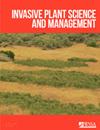Plant naturalization trends reflect socioeconomic history and show a high likelihood of inter-island spread in Hawai‘i
IF 1.2
4区 生物学
Q3 PLANT SCIENCES
引用次数: 1
Abstract
Abstract The composition of nonnative floras is influenced by a region's socioeconomic history, yet rarely are these factors studied alongside plant naturalization rates over time. Such information is especially critical for archipelagos, which often host large numbers of nonnative plants and would benefit from prevention of inter-island spread. We compiled the first record of occurrence and first record of naturalization for all naturalized plants in Hawai‘i alongside data on their origin, native climate types, taxonomy, and likely introduction pathway and compared rates of naturalization with socioeconomic trends. We found that the rate of total plant naturalizations has increased at a roughly constant rate during the past century without any sign of plateauing. However, this relatively steady increase is underlain by notable fluctuations in naturalization rates for different introduction pathways, with ornamentals increasing recently, while agriculture-related plants have decreased. Furthermore, this trend mirrors a shift from an agriculture-dominated economy to a tourism-based one associated with increases in both resident and tourist populations as well as general economic well-being. We further found that the average naturalized species spreads at a rate of 1.86 islands per decade, eventually occupying most major islands in the archipelago, and the rate of spread appears to be increasing since Hawai‘i’s economic shift. Our findings also emphasize the diversity of Hawai‘i’s nonnative flora, which originates from a variety of climates, continents, and taxonomic groups. We demonstrated that many nonnative species have native ranges that include temperate climates, which is important, because these climates typically co-occur with higher-elevation, remnant patches of native-dominated ecosystems in Hawai‘i. This study reveals trends that may help predict a species’ ability to naturalize and spread within and between islands, and we discuss management implications that may be extended to other regions.植物归化趋势反映了社会经济历史,并显示夏威夷岛间传播的可能性很高
摘要外来植物区系的组成受一个地区的社会经济历史的影响,但很少将这些因素与植物随时间的归化率一起研究。这些信息对群岛来说尤其重要,因为群岛通常拥有大量非本土植物,并将从防止岛间传播中受益。我们汇编了夏威夷所有归化植物的首次出现记录和首次归化记录,以及它们的起源、本地气候类型、分类学和可能的引入途径的数据,并将归化率与社会经济趋势进行了比较。我们发现,在过去的一个世纪里,植物总入籍率以大致恒定的速度增长,没有任何平稳的迹象。然而,这种相对稳定的增长是由不同引入途径的归化率显著波动造成的,最近观赏植物增加,而与农业相关的植物减少。此外,这一趋势反映了从农业为主的经济向旅游业为主的经济的转变,这与居民和旅游人口的增加以及总体经济福祉有关。我们进一步发现,归化物种的平均传播速度为每十年1.86个岛屿,最终占据了群岛中的大多数主要岛屿,而且自夏威夷经济转型以来,传播速度似乎在增加。我们的发现还强调了夏威夷非本土植物群的多样性,这些植物群起源于各种气候、大陆和分类群。我们证明,许多非本土物种的本土范围包括温带气候,这一点很重要,因为这些气候通常与夏威夷海拔较高、以本土为主的生态系统的残余斑块共存。这项研究揭示了可能有助于预测一个物种在岛屿内和岛屿之间归化和传播能力的趋势,我们还讨论了可能扩展到其他地区的管理影响。
本文章由计算机程序翻译,如有差异,请以英文原文为准。
求助全文
约1分钟内获得全文
求助全文
来源期刊

Invasive Plant Science and Management
PLANT SCIENCES-
CiteScore
2.20
自引率
9.10%
发文量
24
审稿时长
6-12 weeks
期刊介绍:
Invasive Plant Science and Management (IPSM) is an online peer-reviewed journal focusing on fundamental and applied research on invasive plant biology, ecology, management, and restoration of invaded non-crop areas, and on other aspects relevant to invasive species, including educational activities and policy issues. Topics include the biology and ecology of invasive plants in rangeland, prairie, pasture, wildland, forestry, riparian, wetland, aquatic, recreational, rights-of-ways, and other non-crop (parks, preserves, natural areas) settings; genetics of invasive plants; social, ecological, and economic impacts of invasive plants and their management; design, efficacy, and integration of control tools; land restoration and rehabilitation; effects of management on soil, air, water, and wildlife; education, extension, and outreach methods and resources; technology and product reports; mapping and remote sensing, inventory and monitoring; technology transfer tools; case study reports; and regulatory issues.
 求助内容:
求助内容: 应助结果提醒方式:
应助结果提醒方式:


